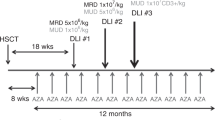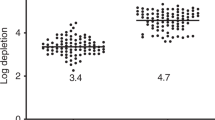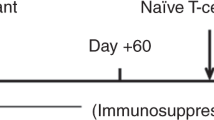Summary:
In an attempt to induce a graft-versus-myeloma effect, we administered donor lymphocyte infusions (DLI) after high-dose therapy with autologous stem cell transplant rescue to seven patients with refractory or relapsed multiple myeloma. High-dose therapy consisted of melphalan, idarubicin and etoposide (days –9 to –6) followed by autologous stem cell infusion on day 0. DLI (five of seven donors with two or three HLA antigens mismatched) were administered on days +1, +5 and +10 along with IL-2 (from day +1 through +12). Six of the seven patients developed acute graft-versus-host disease (GVHD), which resolved spontaneously, coincidentally with autologous hematopoietic reconstitution. One patient failed to engraft and received a second autologous graft. One patient died from complications of a pulmonary hemorrhage after experiencing GVHD. With a minimum follow-up of 38 months, five patients remain without disease progression in complete remission or with minimal residual disease. In this setting, DLI/IL-2 is biologically active resulting in GVHD. A graft-versus-myeloma effect is suggested by the improved outcome of our small cohort of high-risk patients. The use of partially mismatched related donors makes this approach potentially available to nearly all patients.
This is a preview of subscription content, access via your institution
Access options
Subscribe to this journal
Receive 12 print issues and online access
$259.00 per year
only $21.58 per issue
Buy this article
- Purchase on Springer Link
- Instant access to full article PDF
Prices may be subject to local taxes which are calculated during checkout


Similar content being viewed by others
References
Attal M, Harousseau JL, Stoppa AM et al. A prospective, randomized trial of autologous bone marrow transplantation and chemotherapy in multiple myeloma. N Eng J Med 1996; 335: 91–97.
Childs JA, Morgan GJ, Davies FE et al. High-dose chemotherapy with hematopoietic stem-cell rescue for multiple myeloma. N Engl J Med 2003; 348: 1875–1883.
Vesole DH, Crowley JJ, Catchatourian R et al. High-dose melphalan with autotransplantation for refractory multiple myeloma: results of a Southwest Oncology Group phase II trial. J Clin Oncol 1999; 17: 2173–2179.
Bensinger WI, Maloney D, Storb R . Allogeneic hematopoetic transplantation for multiple myeloma. Semin Hematol 2001; 38: 243–249.
Lokhorst HM, Schattenberg A, Cornelissen JJ et al. Donor lymphocyte infusions for relapsed multiple myeloma after allogeneic stem cell transplantation: predictive factors and long-term outcome. J Clin Oncol 2000; 18: 3031–3037.
Ballen KK, Becker PS, Emmons RVB et al. Low-dose total body irradiation followed by allogeneic lymphocyte infusion may induce remission in patients with refractory hematological malignancy. Blood 2002; 100: 442–450.
Porter DL, Connors JM, Van Deerlin VMD et al. Graft-versus-tumor induction with donor lymphocyte infusions as primary therapy for patients with malignancies. J Clin Oncol 1999; 17: 1234–1243.
Porter DL, Luger SM, Duffy KM et al. Allogeneic cell therapy for patients who relapse after autologous stem cell transplantation. Biol Blood Marrow Transplan 2001; 7: 230–238.
Nagler A, Ackerstein A, Or R et al. Adoptive immunotherapy with haploidentical allogeneic peripheral blood lymphocytes following autologous bone marrow transplantation. Exp Hematol 2000; 28: 1225–1231.
Heine U, Tayes C, Wurzinger KH, Maha G . Post transplant engraftment monitoring: overcoming the effect of stutter peaks on accurate quantification. Hum Immunol 2003; 64: 122.
Blade J, Samson D, Reece D et al. Criteria for evaluating disease response and progression in patients with multiple myeloma treated by high-dose therapy and haemopoietic stem cell transplantation. Br J Haematol 1998; 102: 1115–1123.
Massumoto C, Benyunes MC, Sale G et al. Close simulation of acute graft-versus-host disease after autologous bone marrow transplantation for hematologic malignancy. Bone Marrow Transplant 1996; 17: 351–356.
Waselenko JK, Burrows A, Nelson DA et al. Post-transplant interleukin-2 in patients with low grade lymphoid neoplasms previously treated with fludarabine is limited by hematologic toxicity. Ann Hematol 2003; 82: 552–557.
Perez-Simon JA, Martino R, Alegre A et al. Chronic but no acute graft-versus-host disease improves outcome in multiple myeloma patients after non-myeloablative allogeneic transplantation. Br J Haematol 2003; 121: 104–108.
Lokhorst HM, Wu K, Verddonck LF et al. The occurrence of graft-versus-host disease is the major predictive factor for response to donor lymphocyte infusions in multiple myeloma. Blood 2004; 103: 4362–4364.
Klingemann HG . Mini-transplants turning micro: how low can we go? J Hematother Stem Cell Res 2002; 11: 859–862.
O'Donnell PV, Luznik L, Jones RF et al. Nonmyeloablative bone marrow transplantation from partially HLA-matched related donors using posttransplantation cyclophosphamide. Biol Blood Marrow Transplant 2002; 8: 377–386.
Frohn C, Hoppner M, Schlenke P et al. Anti-myeloma activity of natural killer lymphocytes. Br J Haematol 2002; 119: 660–664.
Davies FE, Raje N, Hideshima T et al. Thalidomide and immunomodulatory derivates augment natural killer cell cytotoxicity in multiple myeloma. Blood 2001; 98: 210–216.
Ruggeri L, Capanni M, Urbani E et al. Effectiveness of donor natural killer cell alloreactivity in mismatched hematopoietic transplants. Science 2002; 295: 2097–2100.
Barrett AJ . Mechanisms of the graft-versus-leukemia reaction. Stem Cells 1997; 15: 248–258.
Author information
Authors and Affiliations
Corresponding author
Rights and permissions
About this article
Cite this article
Ballester, O., Fang, T., Raptis, A. et al. Adoptive immunotherapy with donor lymphocyte infusions and interleukin-2 after high-dose therapy and autologous stem cell rescue for multiple myeloma. Bone Marrow Transplant 34, 419–423 (2004). https://doi.org/10.1038/sj.bmt.1704617
Received:
Accepted:
Published:
Issue Date:
DOI: https://doi.org/10.1038/sj.bmt.1704617
Keywords
This article is cited by
-
Autologous reconstitution leading to sustained JAK2-V617F negativity post allogeneic hematopoietic stem cell transplant in JAK2-V617F positive myelofibrosis
Bone Marrow Transplantation (2015)
-
Evidence for anti-tumour effect of allogeneic haematopoietic SCT in cases without sustained donor engraftment
Bone Marrow Transplantation (2010)



